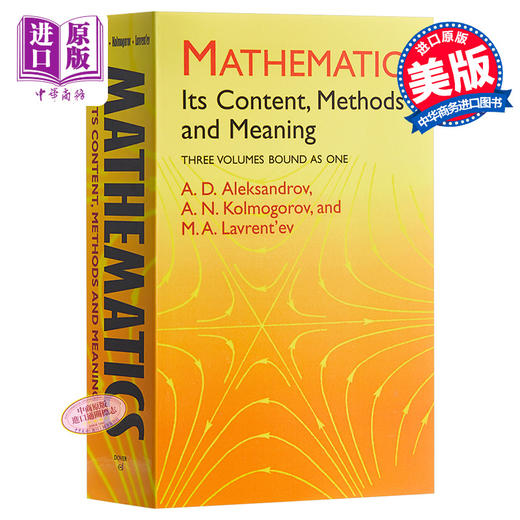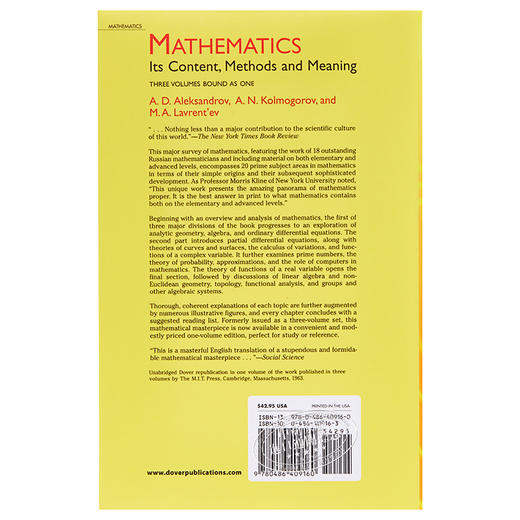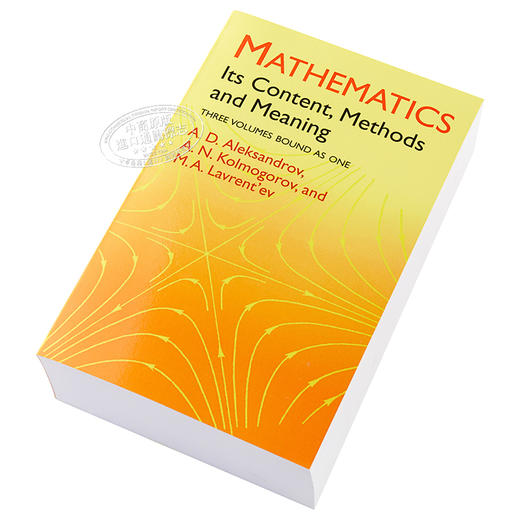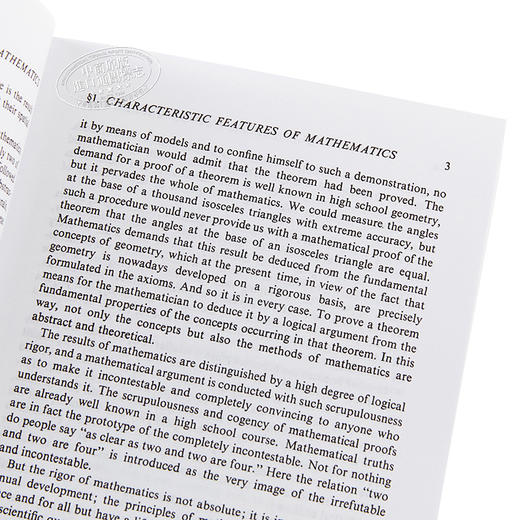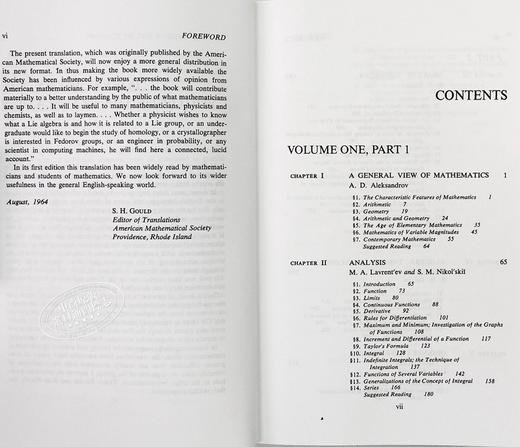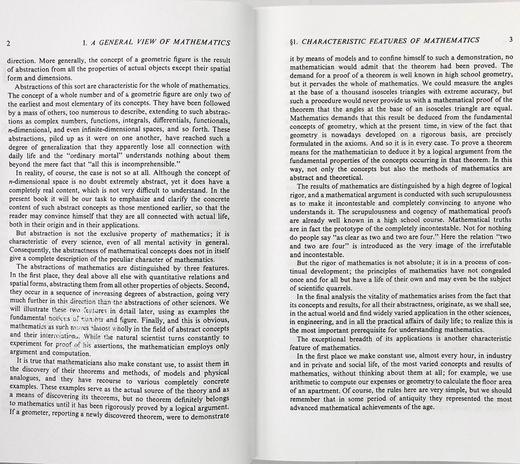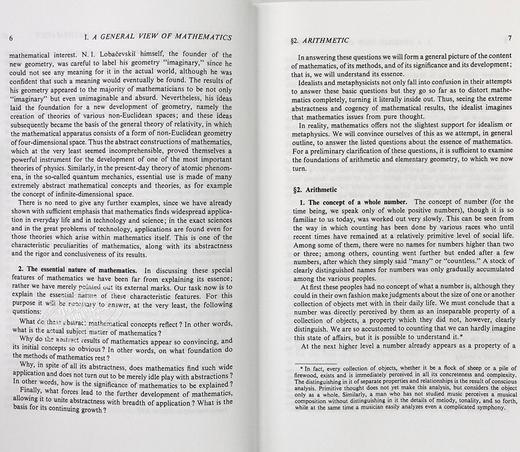【中商原版】Mathematics : Its Content, Methods and Meaning 英文原版 数学:内容,方法和意义 A. D. Aleksandrov等
| 运费: | ¥ 6.50-50.00 |
| 库存: | 4 件 |
商品详情
Mathematics : Its Content, Methods and Meaning 英文原版 数学:内容,方法和意义 A. D. Aleksandrov等
基本信息
Author A. D. Aleksandrov , A. N. Kolmogorov , M. A. Lavrent'ev
Format Paperback | 1120 pages
Dimensions 135 x 214 x 63.5mm | 1,360.78g
Publication date 28 Mar 2003
Publisher Dover Publications Inc.
Publication City/Country New York, United States
Language English
ISBN10 0486409163
ISBN13 9780486409160
页面参数仅供参考,具体以实物为准
内容简介
“……无非是对这个世界科学文化的重大贡献。” -《纽约时报》书评
这项重大的数学调查以18位杰出的俄罗斯数学家的工作为特色,包括基础和高级水平的材料,涵盖了20个数学的主要学科领域,其起源和随后的发展非常复杂。正如纽约大学的莫里斯·克莱恩(Morris Kline)教授指出的那样:“这项独特的著作展现了数学的真面目。这是印刷中数学在基础和高级水平上的*佳答案。”
从数学的概述和分析开始,本书的三个主要部分中的第一部分进行了对解析几何,代数和常微分方程的探索。第二部分介绍偏微分方程,以及曲线和曲面的理论,变化的演算以及复杂变量的功能。它进一步研究素数,概率论,近似理论以及计算机在数学中的作用。实变量的功能理论打开*后的部分,然后讨论了线性代数和非欧几里得几何,拓扑,功能分析以及群和其他代数系统。
许多说明性插图进一步阐明了对每个主题的透彻,连贯的解释,并且每一章都以建议的阅读清单作为结尾。该数学杰作以前以三卷本的形式发行,现在以便捷且价格适中的一卷本形式提供,非常适合研究或参考。
“这是一本惊人而强大的数学杰作的熟练英语翻译。” -社会科学
". . . Nothing less than a major contribution to the scientific culture of this world." -- The New York Times Book Review
This major survey of mathematics, featuring the work of 18 outstanding Russian mathematicians and including material on both elementary and advanced levels, encompasses 20 prime subject areas in mathematics in terms of their simple origins and their subsequent sophisticated developement. As Professor Morris Kline of New York University noted, "This unique work presents the amazing panorama of mathematics proper. It is the best answer in print to what mathematics contains both on the elementary and advanced levels."
Beginning with an overview and analysis of mathematics, the first of three major divisions of the book progresses to an exploration of analytic geometry, algebra, and ordinary differential equations. The second part introduces partial differential equations, along with theories of curves and surfaces, the calculus of variations, and functions of a complex variable. It furthur examines prime numbers, the theory of probability, approximations, and the role of computers in mathematics. The theory of functions of a real variable opens the final section, followed by discussions of linear algebra and nonEuclidian geometry, topology, functional analysis, and groups and other algebraic systems.
Thorough, coherent explanations of each topic are further augumented by numerous illustrative figures, and every chapter concludes with a suggested reading list. Formerly issued as a three-volume set, this mathematical masterpiece is now available in a convenient and modestly priced one-volume edition, perfect for study or reference.
"This is a masterful English translation of a stupendous and formidable mathematical masterpiece . . ." -- Social Science
作者简介
The Russian Equation
Representative of the tremendous impact which Russian mathematicians have had on the Dover list since the Sputnik era is this outstanding book edited by A. D. Aleksandrov and others.
Critical Acclaim for Mathematics: Its Content, Methods and Meaning
"In effect, these volumes present a do-it-yourself course for the person who would like to know what the chief fields of modern mathematics are all about but who does not aspire to be a professional mathematician or a professional user of mathematics. The coverage is extremely wide, including such important areas as linear algebra, group theory, functional analysis, ordinary and partial differential equations, the theory of functions of real and complex variables, and related subjects. . . . What makes these volumes so readable as compared with usual mathematics textbooks is the emphasis here upon basic concepts and results rather than upon the intricate and wearying proofs that make such demands in conventional textbooks and courses. There are proofs in these volumes, but usually they are presented only for the most important results, and even then to emphasize key areas and to illustrate the kind of methodology employed. . . . It is hard to imagine that any intelligent American with a curious mind and some good recollection of his high school and college mathematics would not find many entrancing discoveries in the intellectual gold mine that is this work." -- The New York Times Book Review
"An excellent reference set for bright high school students and beginning college students . . . also of value to their teachers for lucid discussions and many good elementary examples in both familiar and unfamiliar branches. The intelligentsia of laymen who care to tackle more than today's popular magazine articles on mathematics will find many rewarding introductions to subjects of current interest." -- The Mathematics Teacher
"Whether a physicist wishes to know what a Lie algebra is or how it is related to a Lie group, or an undergraduate would like to begin the study of homology, or a crystallographer is interested in Fedorov groups, or an engineer in probability, or any scientist in computing machines, he will find here a connected, lucid account." -- Science
书籍目录
Volume 1. Part 1
Chapter 1. A general view of mathematics (A.D. Aleksandrov)
1. The characteristic features of mathematics
2. Arithmetic
3. Geometry
4. Arithmetic and geometry
5. The age of elementary mathematics
6. Mathematics of variable magnitudes
7. Contemporary mathematics
Suggested reading
Chapter 2. Analysis (M.A. Lavrent'ev and S.M. Nikol'skii)
1. Introduction
2. Function
3. Limits
4. Continuous functions
5. Derivative
6. Rules for differentiation
7. Maximum and minimum; investigation of the graphs of functions
8. Increment and differential of a function
9. Taylor's formula
10. Integral
11. Indefinite integrals; the technique of integration
12. Functions of several variables
13. Generalizations of the concept of integral
14. Series
Suggested reading
Part 2.
Chapter 3. Analytic Geometry (B. N. Delone)
1. Introduction
2. Descartes' two fundamental concepts
3. Elementary problems
4. Discussion of curves represented by first- and second-degree equations
5. Descartes' method of solving third- and fourth-degree algebraic equations
6. Newton's general theory of diameters
7. Ellipse, hyperbola, and parabola
8. The reduction of the general second-degree equation to canonical form
9. The representation of forces, velocities, and accelerations by triples of numbers; theory of vectors
10. Analytic geometry in space; equations of a surface in space and equations of a curve
11. Affine and orthogonal transformations
12. Theory of invariants
13. Projective geometry
14. Lorentz transformations
Conclusions; Suggested reading
Chapter 4. Algebra: Theory of algebraic equations (B. N. Delone)
1. Introduction
2. Algebraic solution of an equation
3. The fundamental theorem of algebra
4. Investigation of the distribution of the roots of a polynomial on the complex plane
5. Approximate calculation of roots
Suggested reading
Chapter 5. Ordinary differential equations (I. G. Petrovskii)
1. Introduction
2. Linear differential equations with constant coefficients
3. Some general remarks on the formation and solution of differential equations
4. Geometric interpretation of the problem of integrating differential equations; generalization of the problem
5. Existence and uniqueness of the solution of a differential equation; approximate solution of equations
6. Singular points
7. Qualitative theory of ordinary differential equations
Suggested reading
Volume 2 Part 3
Chapter 6. Partial differential equations (S. L. Sobolev and O. A. Ladyzenskaja)
1. Introduction
2. The simplest equations of mathematical physics
3. Initial-value and boundary-value problems; uniqueness of a solution
4. The propagation of waves
5. Methods of constructing solutions
6. Generalized solutions
Suggested reading
Chapter 7. Curves and surfaces (A. D. Aleksandrov)
1. Topics and methods in the theory of curves and surfaces
2. The theory of curves
3. Basic concepts in the theory of surfaces
4. Intrinsic geometry and deformation of surfaces
5. New Developments in the theory of curves and surfaces
Suggested reading
Chapter 8. The calculus of variations (V. I. Krylov)
1. Introduction
2. The differential equations of the calculus of variations
3. Methods of approximate solution of problems in the calculus of variations
Suggested reading
Chapter 9. Functions of a complex variable (M. V. Keldys)
1. Complex numbers and functions of a complex variable
2. The connection between functions of a complex variable and the problems of mathematical physics
3. The connection of functions of a complex variable with geometry
4. The line integral; Cauchy's formula and its corollaries
5. Uniqueness properties and analytic continuation
6. Conclusion
Suggested reading
Part 4.
Chapter 10. Prime numbers (K. K. Mardzanisvili and A. B. Postnikov)
1. The study of the theory of numbers
2. The investigation of problems concerning prime numbers
3. Chebyshev's method
4. Vinogradov's method
5. Decomposition of integers into the sum of two squares; complex integers
Suggested reading
Chapter 11. The theory of probability (A. N. Kolmogorov)
1. The laws of probability
2. The axioms and basic formulas of the elementary theory of probability
3. The law of large numbers and limit theorems
4. Further remarks on the basic concepts of the theory of probability
5. Deterministic and random processes
6. Random processes of Markov type
Suggested reading
Chapter 12. Approximations of functions (S. M. Nikol'skii)
1. Introduction
2. Interpolation polynomials
3. Approximation of definite integrals
4. The Chebyshev concept of best uniform approximation
5. The Chebyshev polynomials deviating least from zero
6. The theorem of Weierstrass; the best approximation to a function as related to its properties of differentiability
7. Fourier series
8. Approximation in the sense of the mean square
Suggested reading
Chapter 13. Approximation methods and computing techniques (V. I. Krylov)
1. Approximation and numerical methods
2. The simplest auxiliary means of computation
Suggested reading
Chapter 14. Electronic computing machines (S. A. Lebedev and L. V. Kantorovich)
1. Purposes and basic principles of the operation of electronic computers
2. Programming and coding for high-speed electronic machines
3. Technical principles of the various units of a high-speed computing machine
4. Prospects for the development and use of electronic computing machines
Suggested reading
Volume 3. Part 5.
Chapter 15. Theory of functions of a real variable (S. B. Stechkin)
1. Introduction
2. Sets
3. Real Numbers
4. Point sets
5. Measure of sets
6. The Lebesque integral
Suggested reading
Chapter 16. Linear algebra (D. K. Faddeev)
1. The scope of linear algebra and its apparatus
2. Linear spaces
3. Systems of linear equations
4. Linear transformations
5. Quadratic forms
6. Functions of matrices and some of their applications
Suggested reading
Chapter 17. Non-Euclidean geometry (A. D. Aleksandrov)
1. History of Euclid's postulate
2. The solution of Lobachevskii
3. Lobachevskii geometry
4. The real meaning of Lobachevskii geometry
5. The axioms of geometry; their verification in the present case
6. Separation of independent geometric theories from Euclidean geometry
7. Many-dimensional spaces
8. Generalization of the scope of geometry
9. Riemannian geometry
10. Abstract geometry and the real space
Suggested reading
Part 6.
Chapter 18. Topology (P. S. Aleksandrov)
1. The object of topology
2. Surfaces
3. Manifolds
4. The combinatorial method
5. Vector fields
6. The development of topology
7. Metric and topological space
Suggested reading
Chapter 19. Functional analysis (I. M. Gelfand)
1. n-dimensional space
2. Hilbert space (Infinite-dimensional space)<
4. Integral equations
5. Linear operators and further developments of functional analysis
Suggested reading
Chapter 20. Groups and other algebraic systems (A. I. Malcev)
1. Introduction
2. Symmetry and transformations
3. Groups of transformations
4. Fedorov groups (crystallographic groups)
5. Galois groups
6. Fundamental concepts of the general theory of groups
7. Continuous groups
8. Fundamental groups
9. Representations and characters of groups
10. The general theory of groups
11. Hypercomplex numbers
12. Associative algebras
13. Lie algebras
14. Rings
15. Lattices
16. Other algebraic systems
Suggested reading
Index
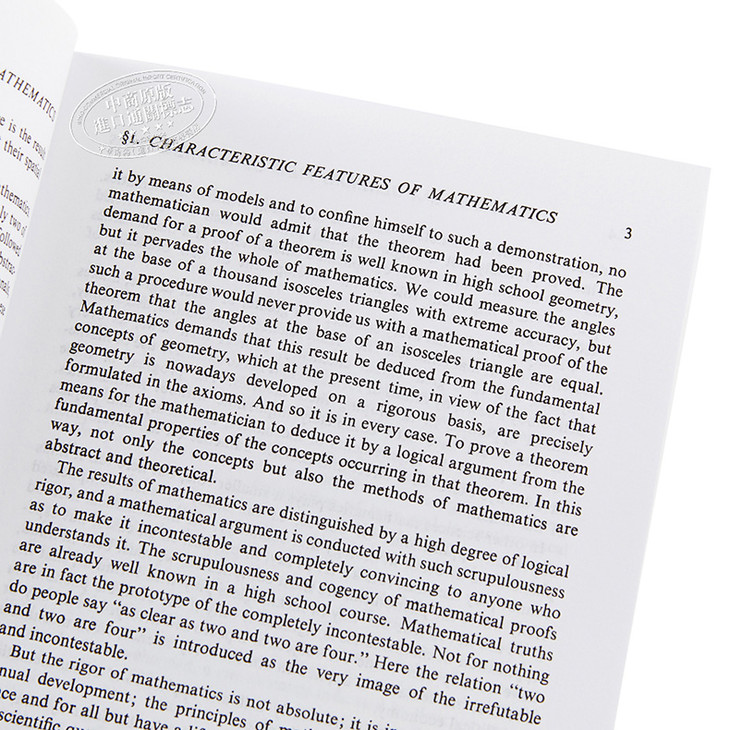
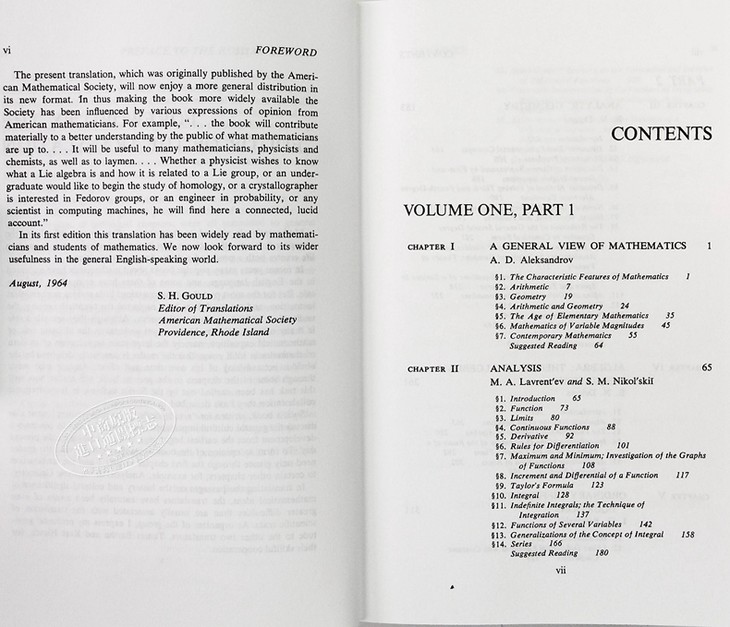
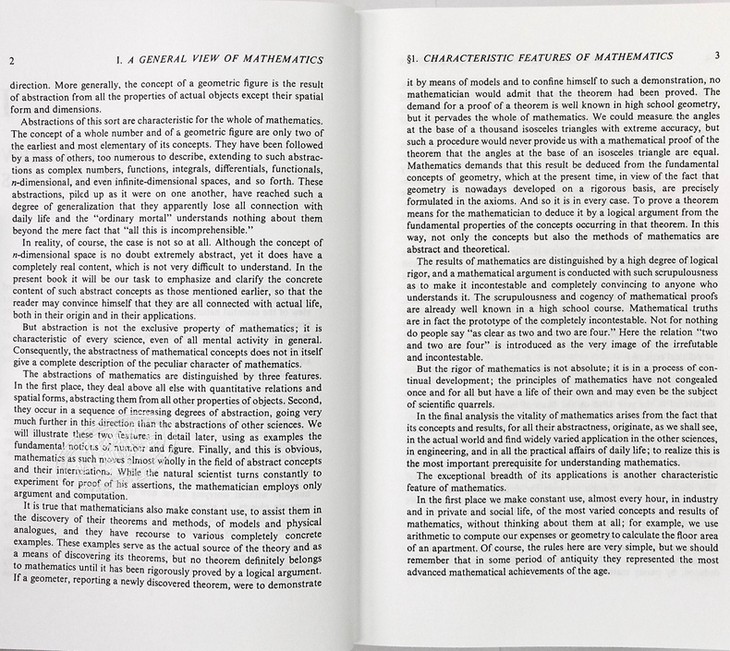
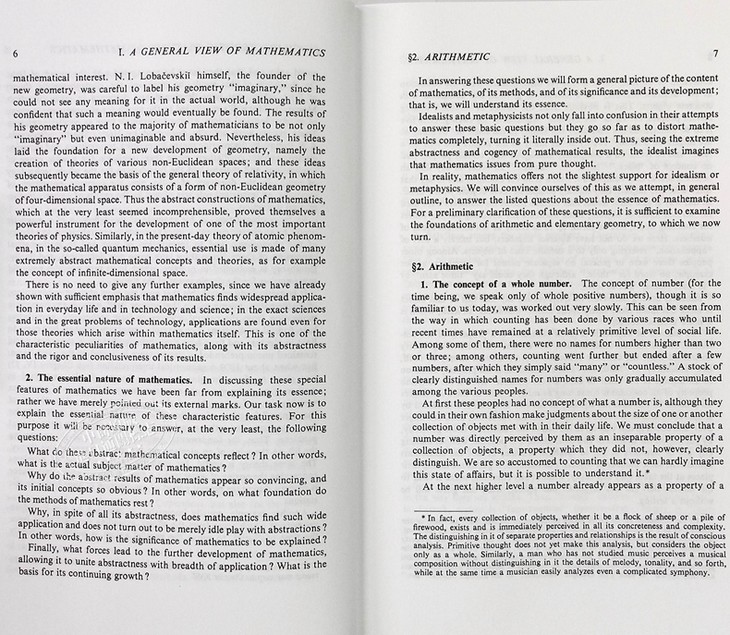
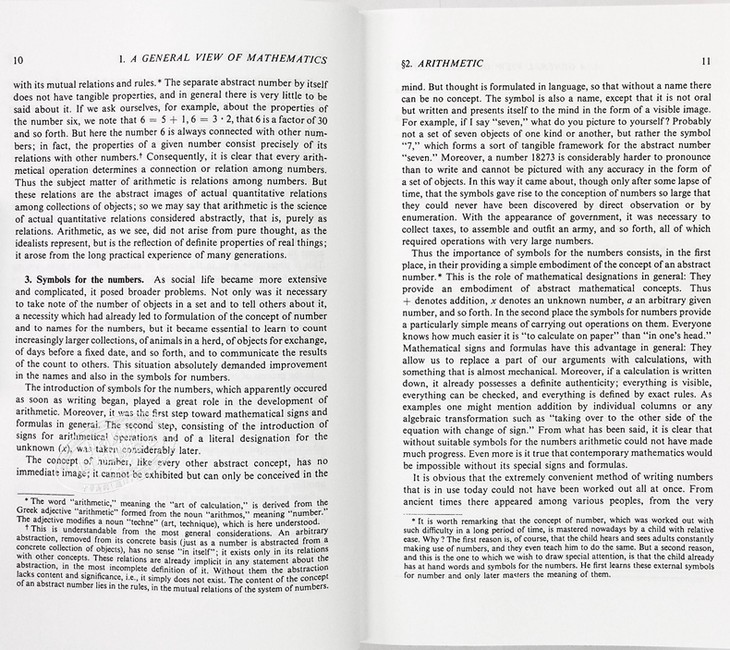
- 中商进口商城 (微信公众号认证)
- 中商进口商城中华商务贸易有限公司所运营的英美日韩港台原版图书销售平台,旨在向内地读者介绍、普及、引进最新最有价值的国外和港台图书和资讯。
- 扫描二维码,访问我们的微信店铺
- 随时随地的购物、客服咨询、查询订单和物流...
